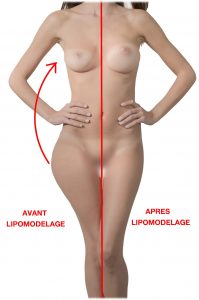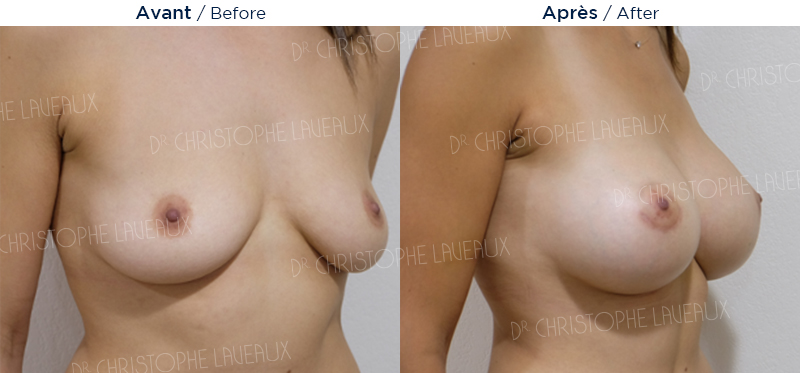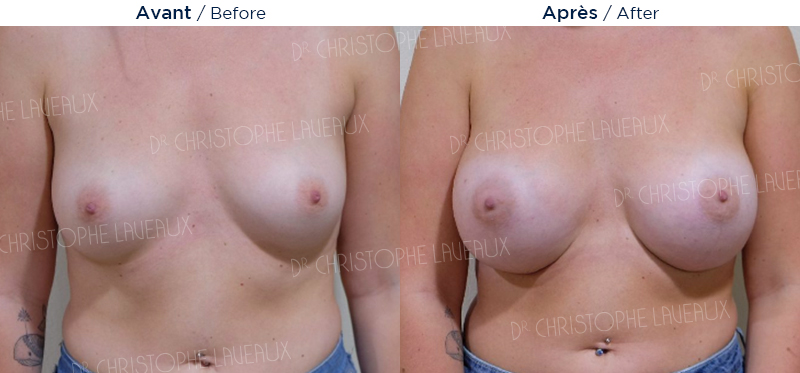Breast augmentation
• Breast augmentation with implants • Breast augmentation by injection •
Breast augmentation with implants
Hypoplasy or hypotrophy of the breasts is a term used for having breasts that are too small in relation to the overall body shape. This can be corrected thanks to the use of breast implants. Hypotrophy may be congenital (from birth) or as a result of a pregnancy, weight loss or a hormonal imbalance. It may be isolated or associated with breast sag (breast ptosis). The patient, who sees this as a violation of her femininity, often resents it. This is generally followed by a decline in self-esteem in social relationships, love and sex life.
Breast augmentation by surgically inserting implants restores the breast volume desired by the patient. To some extent, breast augmentation can
The procedure is performed under general anaesthesia and takes between 1 and 2 hours. The hospital stay is from 12 to 24 hours.
The surgeon places the implant on each side in its pocket either directly under the gland (sub glandular or chest position) or under the pectoral muscle (sub muscularly or sub muscular). In some cases, the implant position is both sub muscular at the neckline and subglandular on the underside of the breast (dual-plane) in order to combine the advantages of both procedures.
The scar may be located either in the armpit (axillary incision) or around the lower half of the areola (areolar incision) under the breast (inframammary route). For the treatment of ptosis, the associated scars are more serious and variable in appearance depending on the degree of ptosis correction.
The range of possibilities (implant position in front or behind the muscle, incision placement, choice of volume and shape of the implant) is such that the surgeon may adapt his technique to suit each patient, thus performing a “tailor-made” breast augmentation.

The implants commonly used are composed of a silicone casing filled with a ‘cohesive’ silicone gel (i.e. a gel which remains intact in one piece even in the absence of a casing).
Saline-filled implants have become obsolete and should no longer be used in routine practice. The saline-filled implants may be the preferred choice of patients because of an unjustified concern about silicone, however the result is less natural, folds or visible waves are frequent and their sudden deflation causes an immediate breast sagging effect.
The pre-filled silicone gel implants provide a more natural appearance and consistency and have a longer lifespan.
What type of breast implants should I choose?
Currently, only smooth or micro textured surfaces are available in France. Round implants are preferred to avoid the risk of rotation related to anatomical implants.
Breast augmentation with implants: what volume for which body-size?
The volume of the implants is determined according to the expectations of the patients but also by the advice of the surgeon who takes into account the actual anatomy of each patient (breast shape, the thorax, silhouette, size of the patient…). During the consultation the patients can test varied sized implants that allows them to visualise the effect of the selected prostheses before the operation.
Complete healing from 2 to 3 weeks
The after-effects can be uncomfortable for the first few days, especially when the implants are large and placed sub muscularly (feeling of painful pressure). If the implants are placed in front of the muscle, the pain is almost non-existent.
In all cases, analgesic treatment adapted to the intensity of the pain will be prescribed.
Edema (swelling), ecchymosis (bruises) and a hindrance to elevate the arms are frequent in the early stages. A drain is not necessary. The dressings are semipermeable, therefore showers are allowed. Special adhesive dressings will need to be applied to the scars for 2-3 months to improve their appearance.
Returning to work is possible between 5-10 days after surgery depending on the job. The patient can resume sporting activities after 6 weeks. Complete healing is achieved within 2 to 3 weeks. The stitches are dissolvable and are concealed. A support bra must be worn 24 hours a day for 1 month.
As with any surgery, a number of complications can occur. But the likelihood of these complications is reduced in the hands of a qualified plastic surgeon and in the presence of a competent anaesthetist. The patient’s compliance to instructions given by the surgeon is also essential and include :
- stopping smoking 1 month before and after the procedure (reduction of all risks) ;
- not taking aspirin for 10 days before and after the procedure (reduced risk of hematoma).
Apart from the traditional complications linked with surgical procedures, some complications are more specific to breast implants :
- The formation of hard scar tissue “capsules” (capsular contracture) is due to a normal reaction of the body against a foreign body. This reaction typically results in the formation of a thin flexible membrane around the implant. Sometimes this reaction is more intense and the membrane becomes thicker. The breast becomes firmer and sometimes even painful. The occurrence of these capsules is unpredictable and can lead to a new procedure to remove or break up the scar tissue (capsulotomy or capsulectomy). Fortunately, advances in the field of implants and surgical techniques have led to a considerable decrease in the rate of capsule creation and their intensity.
- The implants have a limited lifespan. The membrane wears out and eventually becomes porous or breaks up. Violent trauma can also cause a rupture. A rupture can go unnoticed or otherwise cause other symptoms (formation of a capsule, breast deformity). Implant rupture is not serious, but must result in changing both implants.
- Anaplastic Large Cell Lymphoma is a very rare disease that may be due to the macro textured surface of some kind of breast implant. Those implants are now prohibited in France although the risk of ALCL is very low (around 57 patients out of 500 000 patients with implants in France since 2011) and the treatment is efficient in most cases.
• At what age can breast implants be inserted?
In principle, the patient must be at least 18 years old, in order to understand the implications of such a procedure.
But in the case of malformed breasts (tuberous breasts, Poland syndrome) or in patients with severe stunting or the absence of breasts (mammary agenesis), the procedure may be considered at the end of puberty.
• Do breast implants prevent pregnancy or breastfeeding?
With breast implants, pregnancy and breastfeeding are possible and are not dangerous to the mother or the child.
• How long do breast implants last?
Annual checkups by your surgeon and ultrasound is recommended to detect any wear and tear of the prostheses resulting in a replacement implant (appearance of a capsule, change in the appearance of the breast,…).
X-ray examinations carried out on all women from a certain age as part of breast cancer screening, remain possible and are equally a perfect occasion to check the integrity of breast implants.
Present day implants are strong and resistant. As there is no expiry date for prosthesis they do not need to be changed systematically, even after 10 years. Nevertheless, it is always better to change the implants before signs of wear to keep the aesthetic result and to avoid any unnecessary complications. Your surgeon will advise you on the right time to change your breast implants during your follow-up.
• Breast implants or fat injections?
Fat injections (lipomodelage or lipofilling) in the breast may be a substitute for breast augmentation with implants, or complement it by making it more natural.
- Implant Benefits :
- • one initial procedure
- • larger augmentation possible
- • best suited for women with no excess fat
- Benefits of fat :
- • more natural (identical to a natural breast in appearance and touch)
- • life-long resultse
- • nearly non-existent scars
- • associated with liposuction of excess fat (improvement of the silhouette as a whole)
- Implant disadvantages :
- • risk of complications specific to implant (rupture, capsules, infections, rotation or malposition)
- • scars
- Disadvantages of fat :
- • 1-3 initial procedures
- • need fat reserves from the patient
- • variations in results because of weight change
Breast augmentation by injection
This technique involves removing fat by liposuction from areas where there is an excess of fat and then re-injecting it into the breasts. The re-injected or grafted fat must first be purified by centrifugation, filtration or decantation.
All steps take place during the same procedure (collection, purification, re-injection).
Part of the re-injected fat will disappear during the first months following the procedure so that the percentage of remaining fat varies between 50 and 70%. This means that we must inject more fat than necessary in theory to achieve the desired volume (for example, for an augmentation of 100 ml about 150 ml needs to be injected).
To obtain a significant gain in volume, we must have a “reserve” of sufficient fat and sometimes need to perform several sessions of lipomodelage several months apart.
The result is permanent after the partial reduction phase is completed. However, breast size will fluctuate with any significant weight change.
The advantage of this technique is the natural and definitive characteristic of the fat injections. Scarring is minimal. In addition, the patient benefits from two procedures at the same time, aesthetic improvement of the breasts and the silhouette. And lastly, the fat improves skin quality.
The procedure is performed under general anaesthesia and takes between 1 and 3 hours depending on the amount of fat being handled. The hospital stay is 24 hours. The risk of complications and postoperative pain are similar to those caused by conventional liposuction.

For the breasts, the ideal outcomes from this method are:
- improving the neckline;
- moderate increases in size;
- correction of defects or imperfections after breast implants (folds or lumpy implants, indented scarring…);
- correction of asymmetries and malformations (Poland syndrome, tuberous breasts).
This natural breast enhancement cannot however replace all breast augmentation surgery and implants still have their place in the therapeutic arsenal.
Complete healing : From 2 to 3 weeks
The effects for the areas operated on are similar to those after liposuction: bruising for 15 to 21 days, contusion-like pain or aches relieved by oral analgesics and ice packs, swelling that masks the definition of the silhouette which becomes visible after 1 month (permanent change at 3 months), variable levels of fatigue according to the volume of fat removed, and a compression garment that must be worn day and night for one month.
The breasts will remain bruised for 15 to 21 days, but with little discomfort. Their volume appears larger than the final result due to the edema and the expected reduction of 30 to 40% of the injected fat.
Scars induced by lipomodelage are almost non-existent and are limited to several incisions 1 to 3 mm in the breast and areas where the fat was removed.
• Can fat injections in the breast increase the risk of developing breast cancer ?
No. There is, to date, no scientific evidence to suggest that the transfer of fat may promote the development of breast cancer.
However, it does not prevent the occurrence, if it should appear. Each patient has their own risk of breast cancer that depends on their age (there is a 1 in 218 chance before the age of 40, and a 1 in 40 chance between the ages of 50 to 59 years old), family medical history, and breast density.
Therefore, every precaution should be taken to limit the risk of coincidence between the occurrence of cancer and lipomodelage (rigorous assessment done before the lipomodelage procedure by a radiologist specialising in breast imaging; rigorous assessment after 1 year performed by the same radiologist). Taking this into account, the patient requesting breast lipomodelage consents to have the preoperative assessment of breast imaging (mammography, ultrasound depending on their age) and agrees to have the required examinations (mammography, ultrasound) after 1 year.
• Can fat injections in the breast reduce the quality of mammograms ?
No, on the contrary. As with any breast surgery, aesthetic or other (excision of benign or malignant tumor, breast reduction surgery, augmentation mammoplasty …) calcification may occur (related to tissue healing). These calcifications (macro and micro calcifications) however, are different from those observed in the breast, and do not pose diagnostic problems for experienced radiologists.
In addition, the modern techniques of fat transfer allow a more harmonious distribution of fat, hence reducing the risk of oily cyst formation or of poor fat graft setting (cytostéatonécrose).
Currently, we can consider that breast lipomodelage, according to the guidelines of an experienced plastic surgeon in this area, does not cause any particular diagnostic challenge for an experienced breast imaging radiologist.
• Can you still breastfeed after fat injections ?
Yes. Pregnancy and breast-feeding are possible but can alter the result of the fat injections.
A period of 6 months is recommended before or after surgery.
• What will happen in the case of extreme weight change?
The fat that was injected in the breast will follow the weight changes. In the case of significant weight gain the breasts get bigger, conversely, in case of weight loss, the breast volume decreases.
• How many cup sizes can we go up using the lipomodeling technique?
A session using the classic technique allows for an increase of about 1 cup size (once the result is stabilised).
For a larger volume increase, it will be necessary to :
- either the number of sessions performed 3 to 6 months apart.
- or use the Brava system.
- or combine lipomodelling and the addition of a breast implant (in this case the injection of fat conceals the breast prostheses well).
In January 2015, the High Authority of Health (HAS) issued recommendations on the practice of lipomodeling breast implants in cosmetic or reconstructive surgery, thus allowing it to be performed regardless of the age of the patients, subject to certain conditions that your plastic surgeon will inform you of. Read the HAS report.

Breast lipofilling – Result at 1 year after a single session







